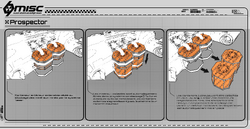No edit summary Tag: Source edit |
No edit summary Tag: Source edit |
||
| Line 7: | Line 7: | ||
|type = |
|type = |
||
|title =[[Radar]] |
|title =[[Radar]] |
||
| − | |image =Placeholder |
+ | |image =Placeholder.jpg |
|description =Radars are used to detect external elements (approaching ships or missiles, debris, etc.). |
|description =Radars are used to detect external elements (approaching ships or missiles, debris, etc.). |
||
|ship = |
|ship = |
||
| Line 27: | Line 27: | ||
|type = |
|type = |
||
|title =[[Fuel intake]] |
|title =[[Fuel intake]] |
||
| − | |image =Placeholder |
+ | |image =Placeholder.jpg |
|description =Fuel intakes are used to manage the fuel supply to the engines, in order to regulate the speed. |
|description =Fuel intakes are used to manage the fuel supply to the engines, in order to regulate the speed. |
||
|ship = |
|ship = |
||
| Line 36: | Line 36: | ||
|type = |
|type = |
||
|title =[[Fuel tank]] |
|title =[[Fuel tank]] |
||
| − | |image =Placeholder |
+ | |image =Placeholder.jpg |
|description =Fuel tanks store the fuel necessary for the operation of the ship. |
|description =Fuel tanks store the fuel necessary for the operation of the ship. |
||
|ship = |
|ship = |
||
| Line 54: | Line 54: | ||
|type = |
|type = |
||
|title =[[Jump module]] |
|title =[[Jump module]] |
||
| − | |image =Placeholder |
+ | |image =Placeholder.jpg |
|description =The Jump Modules allows the ship to travel at high speed between points of interest in the same orbit. |
|description =The Jump Modules allows the ship to travel at high speed between points of interest in the same orbit. |
||
|ship = |
|ship = |
||
| Line 63: | Line 63: | ||
|type = |
|type = |
||
|title =[[Quantum fuel tank]] |
|title =[[Quantum fuel tank]] |
||
| − | |image =Placeholder |
+ | |image =Placeholder.jpg |
|description =The quantum fuel tanks store the fuel necessary for quantum travel. |
|description =The quantum fuel tanks store the fuel necessary for quantum travel. |
||
|ship = |
|ship = |
||
| Line 83: | Line 83: | ||
|type = |
|type = |
||
|title =[[Retro thruster]] |
|title =[[Retro thruster]] |
||
| − | |image =Placeholder |
+ | |image =Placeholder.jpg |
|description =Back thrusters allow ships to provide reverse thrust in order to slow down. They are particularly important for heavy vessels. |
|description =Back thrusters allow ships to provide reverse thrust in order to slow down. They are particularly important for heavy vessels. |
||
|ship = |
|ship = |
||
Revision as of 13:20, 28 February 2021

Typically, ships have attachment points to attach components, weapons, missiles, and accessories. These items can be purchased new from many ship manufacturers or specialty builders; or second hand at waste pickers.
Avionics
Avionics is the on-board electronics allowing to control the elements of the ship and to collect their state.
 |
 |
Propulsion systems
The propulsion systems include all the elements which take part in the propulsion of the ship apart from the thrusters themselves.
 |
 |
 |
 |
 |
Thrusters
The thrusters allow the ship to evolve in its environment. A spacecraft has a very large quantity of them, in order to perform maneuvers in space and in the atmosphere of a planet, in all situations.
 |
 |
 |
 |
Systems
Systems have a direct impact on the functioning of the ship. They protect it, regulate it, and provide it with energy.
 |
 |
 |
Hardpoint matrix
Ship components are defined by three major criteria: Size and Grade and Class.
| Types | Description |
|---|---|
| Size | The size is a classification assigned to every component slot of a ship, only components of matching sizes can be installed |
| Grade |
|
| Class |
|
Weaponry
See Also
References
| Ship Portal | |
|---|---|
